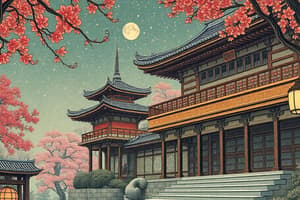Podcast
Questions and Answers
Which statement best describes the relationship between Shintoism and Confucianism in early Japan?
Which statement best describes the relationship between Shintoism and Confucianism in early Japan?
- Shintoism and Confucianism were practiced separately with no interaction.
- Confucianism was adopted as a rejection of traditional Shinto beliefs.
- Shintoism incorporated elements of Confucianism into its existing practices. (correct)
- Shintoism completely replaced Confucianism as the dominant spiritual practice.
How did the introduction of Kanji impact the Japanese written language?
How did the introduction of Kanji impact the Japanese written language?
- Kanji completely replaced the existing Japanese writing system.
- Kanji was adapted to create a new writing system called Kana, suitable for Japanese phonetics. (correct)
- Kanji was primarily used for religious texts and had little impact on daily communication.
- Kanji was directly adopted without any modification by the Japanese.
In what way did Chinese astronomy most significantly influence early Japanese practices?
In what way did Chinese astronomy most significantly influence early Japanese practices?
- Japanese astronomers rejected Chinese texts and developed their own unique methods.
- Chinese astronomy was only used for agricultural purposes with no impact on scientific study.
- Japanese astronomers translated Chinese texts but focused primarily on astrology.
- Chinese astronomical texts guided Japanese astronomy and scientific methods. (correct)
Which concept from Confucianism reinforced the authority of rulers in both China and Japan?
Which concept from Confucianism reinforced the authority of rulers in both China and Japan?
What generalization can be made about the influence of countries in East Asia on each other?
What generalization can be made about the influence of countries in East Asia on each other?
How did Shotoku Taishi attempt to elevate Japan's standing on the global stage?
How did Shotoku Taishi attempt to elevate Japan's standing on the global stage?
What was the significance of the 'Mandate of Heaven' in the context of Japanese emperors?
What was the significance of the 'Mandate of Heaven' in the context of Japanese emperors?
How did Korea influence the transmission of Chinese culture to Japan?
How did Korea influence the transmission of Chinese culture to Japan?
What role did Empress Suiko play in the cultural exchange between Korea and Japan?
What role did Empress Suiko play in the cultural exchange between Korea and Japan?
What geographical factor significantly contributed to Korea's influence on Japanese culture?
What geographical factor significantly contributed to Korea's influence on Japanese culture?
Flashcards
East Asian Countries
East Asian Countries
Countries including Japan, the Philippines, China, and Korea located near the Pacific Ocean by the eastern coast of Asia.
Confucianism
Confucianism
A moral philosophy emphasizing ancestor worship, respect for elders and those in authority, and obedience to state leaders.
Shintoism
Shintoism
Japan's indigenous religion, which adopted aspects of Confucianism.
Kanji
Kanji
Signup and view all the flashcards
Kana
Kana
Signup and view all the flashcards
Mandate of Heaven
Mandate of Heaven
Signup and view all the flashcards
Heavenly Sovereign
Heavenly Sovereign
Signup and view all the flashcards
Shotoku Taishi
Shotoku Taishi
Signup and view all the flashcards
Korean Influence on Japan
Korean Influence on Japan
Signup and view all the flashcards
Buddhism in Japan
Buddhism in Japan
Signup and view all the flashcards
Study Notes
East Asian Countries
- East Asian countries include Japan, the Philippines, China, and Korea, among others near the Pacific Ocean and the eastern coast of Asia.
- Japan is located east of Korea, both of which are east of China.
- China and Korea significantly influenced Japanese cultural, social, and religious development.
Cultural Exchange in Isolation
- China, Japan, and Korea influenced each other's cultural and social development.
Chinese Influence on Japan
- China, one of the first strong states in East Asia, developed complex philosophies, religious ideas, and societal norms.
- China influenced other countries as it grew stronger and developed beneficial relationships.
Confucianism
- Japan borrowed Confucianism from China, integrating it with Shintoism, Japan's indigenous religion.
- Confucianism emphasizes ancestor worship, respect for state leaders, government officials, and parents.
- Shintoism adopted aspects of Confucianism.
Additional Chinese influences include
Astronomy
- Chinese astronomy texts reached Japan through traders, influencing early Japanese astronomical practices.
Kanji
- Japan adopted Chinese characters (kanji), later developing distinctions and adapting them to fit the Japanese language, creating kana to represent unique Japanese consonants.
Divine Right
- The Japanese emperors adopted the Confucian concept of the "Mandate of Heaven" as "Heavenly Sovereign," believing their desires were expressions of the gods and validating their lineage from the Sun Goddess.
Shotoku Taishi's Influence
- Shotoku Taishi, the author of Japan's first constitution, aimed to establish Japan as a respected state and demanded equal treatment from China.
- He sent emissaries to China in the 7th century to study their culture, Confucianism, kanji, and governmental structure.
- After adopting Chinese principles, Taishi insisted that China treat Japan as an equal.
Korean Influence on Japan
- Korea significantly influenced Japan's culture and society.
- Korea introduced Buddhism to Japan, initially introduced to Korea by China.
- Applications of Chinese kanji writing and world conceptions in Japan were influenced by Korean derivations
- Empress Suiko encouraged Japan to adopt Korean culture and invited Korean philosophers and scientists to share their knowledge of writing, music, and world perceptions.
- Korean artisans introduced pottery and ceramics techniques to Japan.
- Korea's geographical location between Japan and mainland Asia facilitated the transmission of religious and cultural influences.
Studying That Suits You
Use AI to generate personalized quizzes and flashcards to suit your learning preferences.
Description
Explore the relationship between Shintoism and Confucianism in early Japan. Understand the impact of Kanji on the Japanese written language. Learn about the influence of Chinese astronomy and the role of Confucianism in reinforcing the authority of rulers in both China and Japan.




